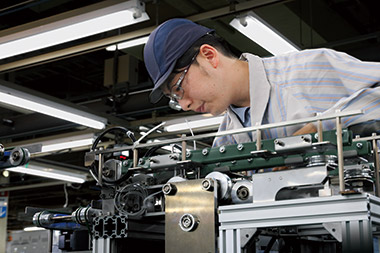What is automation?

Automated equipment for lens production
Automation refers to the use of machines in place of workers to perform tasks that are considered dangerous and/or require considerable physical effort. In the broader sense of the term, automation also refers to the use of machinery to ensure a more reliable and consistent supply of products at the required quality standard.
Thanks to enormous advances in ICT and robotics in recent years, automated machines are now capable of performing tasks involving complex judgments that approximate human decision-making. The days of automation being limited solely to simple tasks are long gone. Once robots and machines are able to perform tasks traditionally undertaken by human workers, that frees us to devote ourselves to more creative work.
At the same time, automation requires input of both time and money. Advanced automation systems involve cutting-edge technology in many different areas, such as high-precision robotics capable of very precise movement; simulation systems for virtual testing of robot operations; camera and sensor systems for real-time operational monitoring; and control systems that use camera and sensor data to generate robot instructions for upcoming tasks. In the real-world production environment, ensuring that machinery operates efficiently and without interruption.
requires a great deal of technical skill and expertise in precision adjustment, which typically comes with years of experience.
Automation throughout the production process
Canon has been developing automation technology for many years. Assembly processes for consumables, such as ink cartridges for inkjet printers and toner cartridges for laser printers, are already fully automated. We are now working to expand automation technology into areas such as final product assembly, parts picking, on-site transport, processing, testing and inspection, and packaging. Eventually, automation will extend to all aspects of monozukuri (manufacturing). The Canon Group boasts an extensive body of technical knowledge and expertise in monozukuri, and Canon is actively embracing the challenge of augmenting this knowledge base with high-productivity automation in development and production processes.
Endurance inspection of camera operation buttons
*In order to view videos, it is necessary to consent to the use of cookies by our website. If the videos are not displayed, please click the "Cookie Settings" and accept cookies.
100% completion quality

Automatic production line for toner cartridges
Canon’s aim is to achieve 100% completion quality through automation.
This comprises two objectives: 100% operating rates for machinery and equipment, with zero downtime due to faults or failures, and 100% quality standards for products and components with zero defects and nonconformities.
Consumer expectations of Canon products and services represent a tremendously important asset for our brand. Canon supplies an incredibly wide range of products to customers all over the world. If even one of those is defective, it impacts our reputation as a reliable brand.
The drive for 100% completion quality represents our commitment to honoring consumer expectations of the Canon brand by striving for the highest possible quality standards. To this end, we are committed to further development and expansion of automation throughout our operations.
Automation of multiproduct production

Production of automated assembly machines (Oita Canon)
The ongoing trend of diversifying market demand and expectations has led to demand for multiproduct manufacturing systems designed to support smaller production runs of different items. Canon is actively working on flexible automation systems that can tolerate variations in quantity or product type, as well as general-purpose automated production machinery capable of manufacturing multiple different products and components.
Automation of recycling
Canon has set up a global network for the collection and recycling of used toner cartridges from laser printers. In Japan, the recycling process is automated as part of a closed-loop recycling system whereby plastic components are retrieved from used toner cartridges and reused in the manufacturing of new cartridges as many times as possible. Automated equipment is also utilized to recycle used ink cartridges from inkjet printers. First, a camera identifies each cartridge model so that it can be disassembled by the automated system. The cartridges are then crushed, and usable materials are extracted, cleaned and converted into plastic pellets for remanufacturing.
Grinding and generating plastic material for toner cartridges
*In order to view videos, it is necessary to consent to the use of cookies by our website. If the videos are not displayed, please click the "Cookie Settings" and accept cookies.



